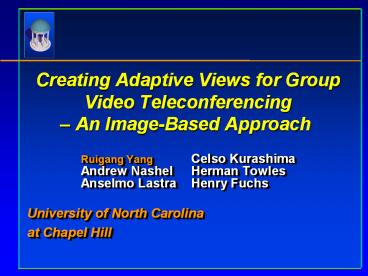Creating Adaptive Views for Group Video Teleconferencing - PowerPoint PPT Presentation
Title:
Creating Adaptive Views for Group Video Teleconferencing
Description:
Cameras. International Workshop on Immersive Telepresence 2002. Slide 5 ... Extract 3D geometry from a few cameras. Less expensive. Hard to get good results ... – PowerPoint PPT presentation
Number of Views:163
Avg rating:3.0/5.0
Title: Creating Adaptive Views for Group Video Teleconferencing
1
Creating Adaptive Views for Group Video
Teleconferencing An Image-Based Approach
- Ruigang Yang Celso Kurashima Andrew Nashel
Herman Towles Anselmo Lastra Henry Fuchs
University of North Carolina at Chapel Hill
2
Current Teleconferencing
Transport
Display
Capture
?
3
The Office of the Future
4
Group Teleconferencing
Cameras
- Multiple persons (3-4) at each site
- Life-size, monoscopic display
- High-resolution seamless imagery
- Active view control
5
Active View Control
Provide the best approximating view
6
Active View Control
- A view synthesis problem
- Extract 3D geometry from a few cameras
- Less expensive
- Hard to get good results
- Image-based method capture many images
- Looks really good on every scene
- Need many images
7
Our Image-based Approach
- Observation Eye level remains relatively the
same during a conference session - A compact Light Field representation
- Parameterized by a 3D function (s, u, v)
8
Linear Light Field
9
LLF Rendering
- Projective Texture mapping and blending
- Tessellate the focal plane
- Project input images onto the focal plane
- View-dependent blending
New view
Focal Plane
Base image
10
Blending Function
Focal Plane
11
Samples Images
Perspective Projection
Orthogonal Projection (extreme case)
12
Sampling Analysis
- Configuration parameters
- Focal plane depth D
- Cameras FOV
- Cameras horizontal resolution W
- Inter-camera distance d
- Error term pixel drift (e)
Given the configuration parameters, and a desired
error tolerance e , what is the maximum depth
deviation ?D from the optimal depth D.
13
Sampling Analysis Result
14
More results
- Distributed System
- 11 cameras
- 6 capture PC ( 640x480)
- ROI encoded
- JPEG compression
- One rendering PC
- Roughly 1000 x 480 output
- 4-7 frames per second
15
Conclusions
- We presented a novel system designed specifically
for group video-teleconferencing. - Best approximate view for the group
- Photo-realistic results at interactive rate
- Flexible and scaleable
16
Acknowledgements
- Funding support from
- The Department of Energy's ASCI VIEWS Program
- Sandia National Laboratories USA
- Collaborators from Sandia
- Phil Heermann
- Christine Yang
- Corbin Stewart
17
The End
Thank You































